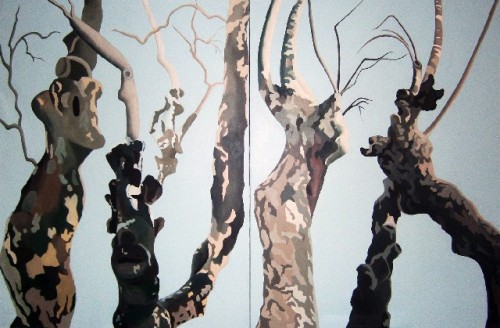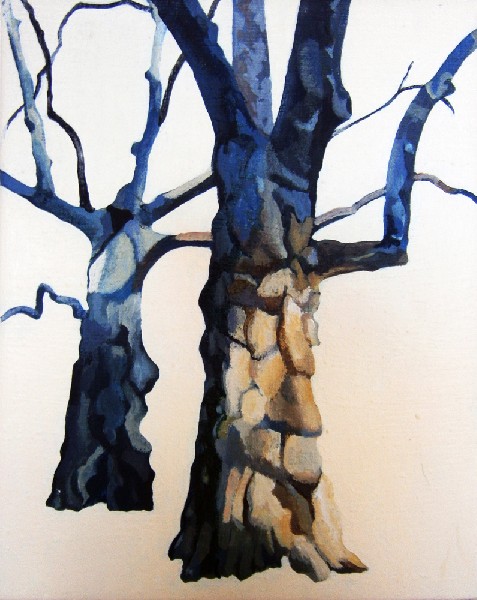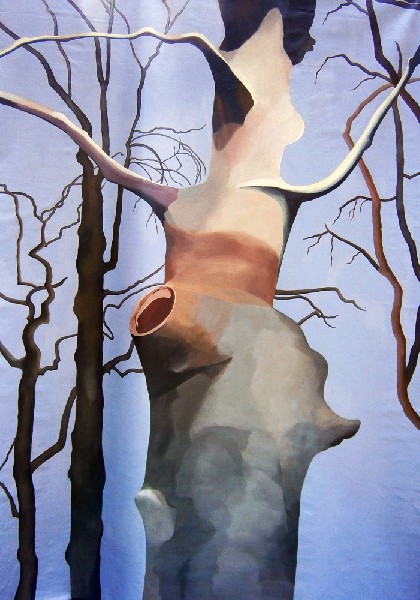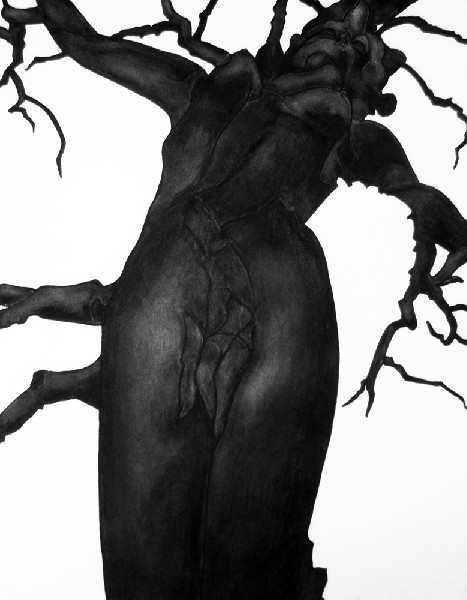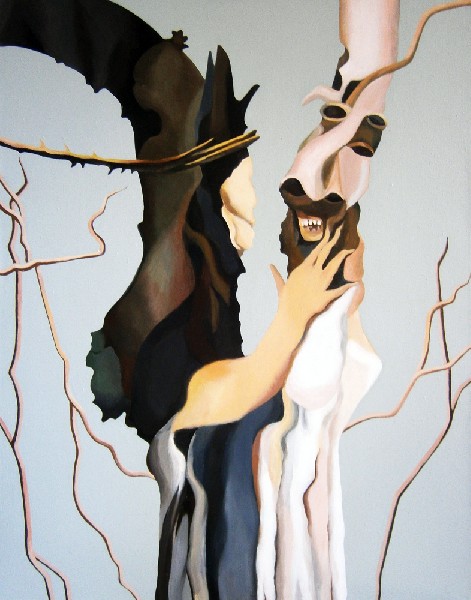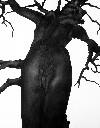Dialogue with Artist Mary Hrbacek
Peopled Forest of My Mind
By: Edward Rubin and Mary Hrbacek - Apr 24, 2013
Mary Hrbacek’s solo exhibition Peopled Forest of My Mind curated by Elga Wimmer is on view at the Creon Gallery in New York City from April 10-30, 2013. It features her very small and very large, personified tree paintings.
Inspired by her dense dramatic charcoal drawing, executed on stark white paper, Hrbacek cultivates eerie hybrid plant forms as they emerge through the drawing process, coaxing these unfathomable figural apparitions into coherent, energized human-like entities that disclose the organic origins of all natural systems. The works stress our primal link to nature in an increasingly high tech global existence.
We spoke with Mary Hrbacek by phone, as well as, via email on April 23, 2013.
Edward Rubin: Why Trees? What is it that made you start painting trees? Give us a little history of what made you switch from painting rocks to portraits of trees.
Mary Hrbacek: Good question! After doing the intricate Southwest rock series, I needed a respite from working abstractly. Because of asthma I couldn't use oil, turpentine or acrylic so I used a heavy textural surface on which I dripped inks. Eventually I realized I needed an image to work from to make my art convincing. At that time I had no studio so I spent my time in Riverside Park, an area full of Sycamore trees. The peeling bark and natural patterns attracted me, and I began to draw the trees, at first without realizing their anthropomorphic possibilities.
ER: I have heard people referring to you as a “curator of nature,” a moniker I rather love. How do you choose the trees that become your subjects?
MH: Actually, I don’t select my subjects they choose me! When I find that a particular tree rivets my attention I cannot ignore it. I photograph various viewpoints choosing evocative human-like forms that often suggest gender. I often make several drawings and paintings of the same compelling subject.
ER: Many of your early tree paintings appear to be anthropomorphic. Is this something that you realized, or perhaps even felt at the time?
MH: In 1997 I started to walk in Riverside Park every day and I would sit down and work on my pencil drawings. At that time I also was drawing from live models. One day my vision changed! I saw the trees in a totally new way, with limbs and other body parts closely related to human anatomy. I realized that the trees that attracted my attention appeared to be anthropomorphic. I felt astounded when my vision changed, as the tree limbs and human anatomy merged in my psyche. The anthropomorphic quality sets these trees apart, and makes them powerful and memorable.
The subject of the tree invokes lore from the earliest of human experiences. The Egyptians believed that "souls" rested in Sycamore trees before their long journey across the desert to the next world. Tree roots penetrate as much as 70 feet into the earth's surface bringing nutrients produced through the sun by photosynthesis deep into the earth. I view trees as objects of significance and interest. I admire them. They matter to me in the way that a friend matters. Exploring their forms in my art nurtures my life and sustains my intellect and imagination.
ER: This may sound silly, but in your travels around the world you have painted all kinds of trees. What is it that attracts you to a particular tree? If trees can be said to have individual personalities, have you found any differences among the various types of trees that you have captured. Do trees talk to you, so to speak, and in what ways?
MH: Your question doesn't sound silly at all! I am especially attracted by trees that bring the anthropomorphic vibe out strongly. For instance, to me my painting Dark Monarch looks exactly like a king seated on a throne and Hanging Suspended especially evokes an upside down male torso. The trees are actually as different as humans. They come in all kinds of shapes and sizes, but their persona or personality accentuates their unique identity most strongly. Actually, once in Riverside Park I heard a faint whisper. I looked up to see where the sound came from. I immediately noticed a tree with sap seeping from a broken limb. Go figure!
ER: When you see a tree that you know you want to paint do you draw it first or do you take a photograph. In other words what is your process from first seeing a tree that you'd like to paint to the finished painting itself?
MH: If I could sit on the spot to draw every tree I find in my travels I would.
Since I move from place to place, country to country when traveling, I find I must take photographs so that I can later explore the forms in my highly intuitive charcoal drawing process. Then I translate the image into an acrylic painting on linen. I am very particular about the forms. I do not stop working on a painting until I get to a point that satisfies the excitement I derive from clearly honed forms.
ER: In this exhibition you are showing your charcoal drawings, a first as far as I know. When do you use charcoal, and how did you come to create such black charcoal drawings?
MH: I’ve have shown my charcoal drawings before, though not lately I admit. Curator Elga Wimmer liked these drawings and thought they should been seen alongside my paintings. Charcoal is the oldest medium used by humans. It is also made from tree bark. I have used Stonehenge printmaking paper for years. One summer the manufacturer sealed the sheets so that I had to press down very hard to make the charcoal adhere to the paper. I knew instantly that this was an important development in my work.
ER: I've seen a number of your exhibitions, the most recent being Covert Narratives, a group show this past February at the Tenri Institute here in New York City, and now this solo exhibition, and each time, just when I think "what can she do now and where can she take this” you surprise me by adding new elements, an odd twist, or a change in the size and shape of the canvases you use. At Tenri you added human and animal figures into your paintings. I loved this touch. In this exhibition at Creon we are greeted by a wall of very small paintings and then we meet all six by nine feet of The Wanderer which you said is your largest work to date. What is the process, the challenges, the adjustments that you have to make in going from a small work to such a large work as this?
MH: I think I am becoming less of an "outsider" in my life, which is having an impact on my imagery. Unconsciously, I have been adding several figures that relate to one another instead of focusing on a single lone tree. I am less afraid of people now, than I was for a long time. I feel more safe and confident than I once did. It is hard to fathom the fact that a small work can be even more difficult to resolve than a larger piece. The brushes one uses are very tiny, but the image must be convincing, done "just right" to be both established and believable. My eyes were quite strained from working on the small pieces. The large work took everything I have both physically and emotionally to complete. I had to go back in to deepen the forms to resolve and elaborate on areas that I had hoped were done. It takes a lot of tenacity to work large but I intend to expand my repertoire in the near future by working on large pieces in both horizontal and vertical rolls. I like having The Wanderer hang loosely from the top. To me, it looks very playful and organic. It is challenging but it is also exciting to break out of the "usual" rectangular format. I am ready for the change and the challenge, thanks to my new audience whose responses are inspiring me.
ER: The backgrounds of your paintings appear to play a very important part of your paintings. Can you talk to this? Can you tell me how you select your backgrounds as far as color? Is the time of day involved in what colors you select?
MH: I paint the backgrounds in a flat graphic mode in order to separate the image from naturalistic references. I want to accentuate the personality of the specific tree to elaborate its unique forms and attributes. The color is related to the form by either harmony or by contrasting tone. A color from within the tree may work to unify the image when it is applied to the background space. I often change the space surrounding the tree form many times to get the right hue and tone, but it doesn't relate to time of day, location or season of the year.
ER: Mary, tell my why you don’t place your trees in a more naturalistic setting?
MH: I want to present my subjects in an isolated, symbolic space that sets them apart from their environment and from art historical associations. The tree becomes the total focus of the painting. This choice gives me the freedom to accentuate the tensions, the gestures and the emotions that specific tree forms evoke.
ER: I see that you like to use flat colors as a surrounding ground?
MH: The flat harmonious colors I use in the background are intended to highlight the sculptural character of the shapes which provides the slightly disjointed aura that transports the pieces out of conventional time and location.
ER: Your paintings have an animated Disneyesque quality to them. On the one hand they appear carton-like, say a still from a Disney film, and on the other hand one also thinks of the naturalism of Audubon, though with a lot less detail of course. Is this a quality you aim for?
MH: Good point! The Disneyesque quality arises from the simplicity and cartoon-like animation of the movement in some of my tree forms. Because my vision is not figurative but representational, I tend to omit realistic detail. It doesn't interest me. I just want to establish the authenticity of my images. Perhaps these factors account for the "cartoon" character of some of my works. I don't relate to or think about Audubon at all. However, because nature is the source of the works, they may conjure thought of Audubon.
ER: All of your paintings have titles that seem to be part of your whole presentation. How do you go about choosing titles?
MH: I choose titles suggested by the works themselves. For instance, The Wanderer strikes me as a figure that is in a perpetual state of searching for meaning for what matters in life. This does suggest a myth like the Myth of Sisyphus but to me it also makes sense in an everyday way. The piece Woman Entwined is one of my repeated power images that reflect the feelings I have had of being "trapped" in my life. This tree-woman is bound by nature to the vines that surround her. The piece called Imploring refers to what appears to be a female tree, with arms outstretched making a plea to the departing “male" figure who has apparently had enough! All these meanings are obviously metaphoric and symbolic of course. I hope these remarks illuminate my art for the viewer.
ER: What's Next? Can you tell us what's coming down to pike? What to expect. Or is this something you only know when you arrive at it?
MH: My art is totally intuitive. I don't think about "theory" or concepts.
Because my images are driven by the motif I never know what to expect. I am open to the configurations and networks that originally attracted me within the subject. I do find that I am focusing more on multiple tree trunks with clear figurative elements whose underpinnings hint at drama or relationships. I find my work is more prone now to establishing fables and myths about anthropomorphic figures from the woods. Witch and Bewitched is a good example of this direction.
Mary Hrbacek: Peopled Forest of My Mind
April 10 – 30, 2013
Curated by Elga Wimmer
Creon Gallery
238 East 24 Street, 1B NY, NY 10010
Norm Hinsey Gallery Director 646-265-5508
HOURS: Wed. & Thurs. 6:30 -8 p.m., Sat. 12 – 6 p.m. or appt.


